WinHEC 2005: Coverage Wrap
by Derek Wilson & Jarred Walton on April 29, 2005 2:00 PM EST- Posted in
- Trade Shows
More from the Expo Floor
While the show floor certainly wasn't as big as what we're accustomed to seeing at E3 or some of the other shows, there were still a few other items that we found interesting. There isn't really a central theme to this, so just pretend you're walking around the exhibition floor with us bouncing from networking to PCI Express to servers, all the while passing LCD displays showing DVD and HD content. And just for the record, CRTs are basically dead. There wasn't a single CRT present at WinHEC, and no one is interested in trying to improve the technology. Even if you love your current 22" CRT, we expect by the time you're ready to upgrade, any CRTs will be at least as old as what you're already using. That tangent aside, here's some of the other exhibits we saw on the floor.Alienware Gaming Zone
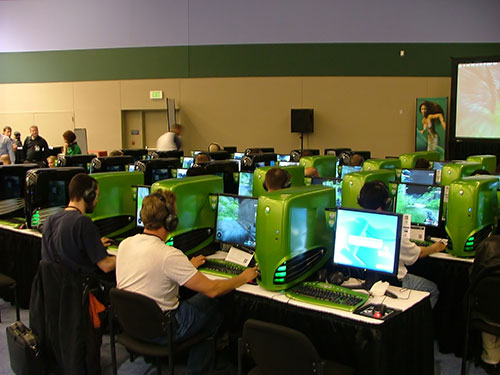
There was a large gaming arena set up in one corner with 30+ Alienware systems. All of the systems were running XP-64 with a 64-bit build of Far Cry. System hardware consisted of Athlon 64 4000+ CPUs with 1GB of RAM and GeForce 6800 Ultra graphics cards. The two game servers were running SLI with (we think) 2GB of RAM in spectator mode. We couldn't really see any difference between the 64-bit version of Far Cry and the "old" 32-bit version, but we were told that it was "substantially faster". Hopefully, we can get the test version back into our labs to validate - or disprove - these claims. We didn't bother participating in the competition where the winner walked away with some hot hardware, but [*cough*] we figure it's nice to let someone else win now and then.
Intel's Dual Core Itanium (Montecito)
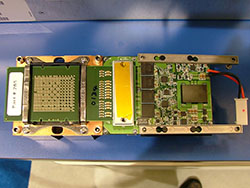 |
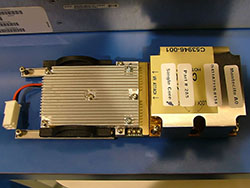 |
| Click to enlarge | |
As far as we're aware, this is the first demonstration of Montecito running at full clock speeds (2.0 GHz). We might have that wrong - on both the clock speed and the "first" claim - but whatever the case, Intel did have a Montecito server present. Just to recap, the Itanium 2 Montecito chip is a dual core processor with SMT/HyperThreading on each core. It tips the scales at a mere 1.72 billion transistors, nearly fourteen times the size of the Prescott core (and made using the same 90nm manufacturing process). Of course, most of those transistors go to the 24MB L3 cache - we'd guess somewhere around 1.4 billion transistors just for the L3 cache and logic, if not more. Running in a dual socket motherboard, the result is eight virtual processors, as you can see in the following screenshot.
Intel's Pelston and Foxton Technologies
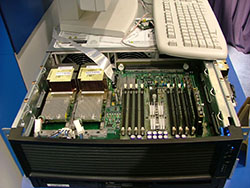 |
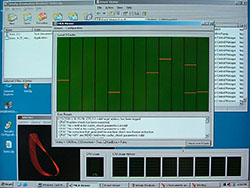 |
| Click to enlarge | |
The server was running the Itanium version of Windows (we're not sure if it was XP-64 or the older Windows for IA-64), but that wasn't really important. What was important was that the chips were up and running and Intel had a demonstration of some of the new technologies for the platform. One of the new technologies present in Montecito is called Pelston. The Pelston technology, if you haven't heard of it, is a way for Intel to increase the yield and reliability of the Montecito processors. With the massive L3 cache, it's pretty much inevitable that there will be defects. Pelston allows the processor to detect cache errors and deactivate the faulty cache lines. The "MCA Viewer" application in the above screenshot shows the results after a second system simulates the failure of various cache lines - 10 so far in the example. Those of you who might worry about the loss of performance with decreased amounts of cache, have no fear: Intel will replace chips that develop more than 90 faulty cache lines (less than 0.1% of the total L3 cache).
Another technology present in Montecito that we didn't see demonstrated is called Foxton. Foxton allows for dynamic overclocking of the processors if certain thermal and load conditions are met. With a sufficient cooling setup, the processors can run at up to 2.2 GHz, at least periodically. That's only a 10% overclock, and it's not even guaranteed, but it's interesting for an Enterprise Class server chip nonetheless. Again, Intel reiterated that Itanium is not a dead technology. They further elaborated that "there are technologies present in the Itanium platform that you can't get with Xeon." The real competition for Itanium 2 comes from IBM POWER5 and Sun ULTRASparc, and with a cost of around $5000 per Montecito processor, Intel is actually something of a "bargain" by comparison.
AMD's Quad Opteron
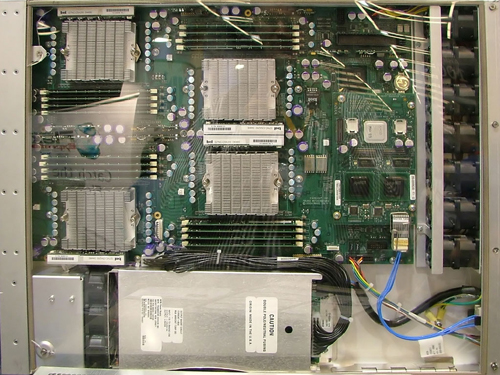
While we're on the topic of servers, AMD had the above Quad Opteron system running with 16GB of RAM (or possibly 32GB - we couldn't confirm the exact amount). It wasn't doing anything particularly useful at the time, and we couldn't determine if the system was using the new dual core Opteron chips or not. If it was, a "wrestling match" between it and the earlier Montecito server might have proved interesting. It might be difficult to setup an apples-to-apples test, however, as the Itanium does rather poorly when running x86 code and it doesn't support x86-64.










17 Comments
View All Comments
JarredWalton - Wednesday, May 18, 2005 - link
JimmyTalbot, the Avalon cylinder demo was done on a laptop for us but one of the developers. It was basically meant as a "proof of concept". She said it took about one or two days to create - i.e. it was much easier than current Windows APIs. As far as I know, it's not available to the public or anyone outside of MS. Sorry.JimmyTalbot - Monday, May 16, 2005 - link
I should have specified: I got the WinFX (Avalon) Beta SDK hoping to find the sample in there, but it's not included.JimmyTalbot - Monday, May 16, 2005 - link
Does anybody know if/where I can get the "3D Picture Viewer" demo shown on page 1 of the article?Doormat - Monday, May 2, 2005 - link
I think the idea of browsing in the BIOS is fascinating. Even with WinXP its still 1-3 minutes or so to get to a usable browser or mail program. If all you needed to do is check your mail real quick, why not just go into the BIOS and forget about booting all the way into windows, and then shutting down.Fricardo - Monday, May 2, 2005 - link
"The other interesting comment from Barry was that he stated AMD will be using DDR2 in a future processor. We had asked if they might simply skip DDR2 altogether and head straight to DDR3, and he said they would not be doing so."Now that is interesting. I've been wanting to know that for months. Strange how the most useful part of the article was a talk with an AMD employee. Thanks guys.
Tujan - Sunday, May 1, 2005 - link
The funny thing about Windows is that the development areas seem oblivious to fact that testing of succesful programs are done on high-end systems wich then we see with the OEMs giving underperforming system to the masses.The graphics ideas are great,sure,but on 'when''the default graphics will be able to take and PASS the test the big boys are working with.
Windows interface for Longhorn,sure looks like the same barnyard.So we will have to rely on other vendors, and programs such as WindowsBlinds to add deriviative to such things as different colored buttons in a dialog box.
Again why so,a system font size cascades 'all windows.Nothwithstanding,getting pass security to customize your own computer now. Why does the interface remain nothing more than a very expensive colored lightbulb,and a glorified printer.
Hello,'integrate the icons into the 'program ? Sure we see the 'how-it-works. But why does it have to work at all.Is this going to keep us from creating our own icons for our own 'visual aids.Wich most all of retails off-the-shelf instructions for 'Long Horn,will invariably be in print.Now just imagine the trees for example.
So why dont you integrate the add/remove programs to the 'File Associations.? Isn't this explicit enough to keep from having those undocked windows fish flying from one pond to another.
Get rid of DOS.Think the learning expression traveling this train is simply to head for the caboos,and jump off.You would certainly be at the conductors point of reference then right ?
Im ready for a Virtual windows machine running technology all the way to the 60s.But we in the real computer world only imagine.Imagine that syntax doesn't come with noun,verb,subject and predicate. Much less have a reference that tells you so. Rather than giving somebody the rug by saying lets do the media,then I told you so.
Good luck.And wheres the beef ?
DerekWilson - Sunday, May 1, 2005 - link
In hind sight, Anand is probably right about Longhorn being more advanced than Tiger ... But the direction and (lacking) demos we saw didn't give us the warm fuzzy feeling we would expect.Of course, the ammount of cash Microsoft has laying around to make something happen if they need to would make anything possible ... My real question is: do they think they need to?
Give both Apple and MS a year and a half, and we could have an interesting feature battle on our hands depending on how much Apple can push themselves and how much MS cares :-)
Icehawk - Saturday, April 30, 2005 - link
I'm very curious as to how the UEFI Bios works, very intriguing to me.***
I think it is interesting that in Anand's Tiger article he says that Longhorn should be more advanced but this articles suggests it will be at on par, at best. I wonder which it will be?
***
3D on servers? Now that is a waste of resources and money. If a particular app uses it, OK then I'll budget the resources. But why should I need 3D to run IIS/FTP/etc?!
Well software wouldn't be anywhere without hardware, would it?
The market is pretty stagnant right now so I guess pushing 3D onto all desktops and making a gpu/cpu intensive OS should ensure some huge rounds of upgrades. Server-side almost none of them have 3d cards, or if they do very weak built-ins for the most part. On the desktop a P3 1ghz with 512mb of RAM is still *passable* on XP, that is a 5 year old machine. Something even slightly more robust like a 1.4ghz K7 with 1gb of RAM still runs everything but games without too many issues.
Guess they need to do something to make me want to upgrade again - I just went from that 1.4 K7/GF4 to a 3.2 P4/6600GT and don't see any offerings on the 1-2yr horizon causing me to upgrade otherwise. DC would be nice with my usage but raw processing power...? Only in games. That was the only reason I upgraded at all now, I would have waited if I could have otherwise as my old machine ran everything up until D3/HL2 fairly well.
stephenbrooks - Saturday, April 30, 2005 - link
...or post comments while you're in your BIOS.xtknight - Saturday, April 30, 2005 - link
awesome...I can't wait to get ahold of a WGF2.0 card and Longhorn. sounds like that will provide for some awesome effects I could put in my programs. UEFI looks kinda interesting as well. web browser in a BIOS is going too far IMO, though. they need to keep in mind this is just for diagnosing your pc. on the other hand you could download drivers or search for troubleshooting information from anandtech forums, while you're in your BIOS :)